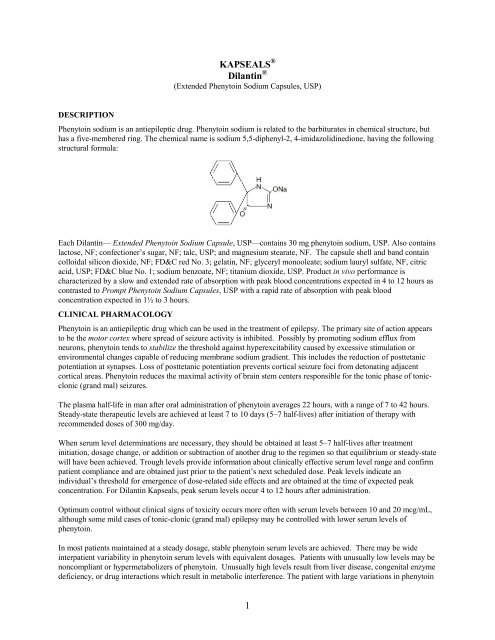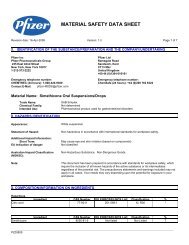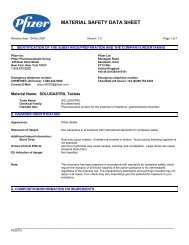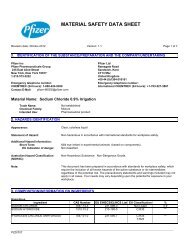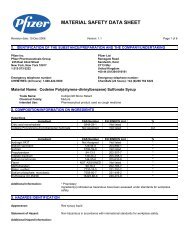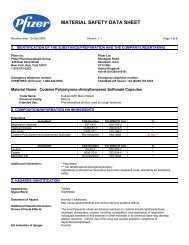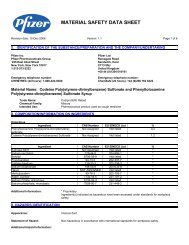Phenytoin (Kapseals) - Pfizer
Phenytoin (Kapseals) - Pfizer
Phenytoin (Kapseals) - Pfizer
You also want an ePaper? Increase the reach of your titles
YUMPU automatically turns print PDFs into web optimized ePapers that Google loves.
DESCRIPTION<br />
KAPSEALS ®<br />
Dilantin ®<br />
(Extended <strong>Phenytoin</strong> Sodium Capsules, USP)<br />
<strong>Phenytoin</strong> sodium is an antiepileptic drug. <strong>Phenytoin</strong> sodium is related to the barbiturates in chemical structure, but<br />
has a five-membered ring. The chemical name is sodium 5,5-diphenyl-2, 4-imidazolidinedione, having the following<br />
structural formula:<br />
Each Dilantin— Extended <strong>Phenytoin</strong> Sodium Capsule, USP—contains 30 mg phenytoin sodium, USP. Also contains<br />
lactose, NF; confectioner’s sugar, NF; talc, USP; and magnesium stearate, NF. The capsule shell and band contain<br />
colloidal silicon dioxide, NF; FD&C red No. 3; gelatin, NF; glyceryl monooleate; sodium lauryl sulfate, NF, citric<br />
acid, USP; FD&C blue No. 1; sodium benzoate, NF; titanium dioxide, USP. Product in vivo performance is<br />
characterized by a slow and extended rate of absorption with peak blood concentrations expected in 4 to 12 hours as<br />
contrasted to Prompt <strong>Phenytoin</strong> Sodium Capsules, USP with a rapid rate of absorption with peak blood<br />
concentration expected in 1½ to 3 hours.<br />
CLINICAL PHARMACOLOGY<br />
<strong>Phenytoin</strong> is an antiepileptic drug which can be used in the treatment of epilepsy. The primary site of action appears<br />
to be the motor cortex where spread of seizure activity is inhibited. Possibly by promoting sodium efflux from<br />
neurons, phenytoin tends to stabilize the threshold against hyperexcitability caused by excessive stimulation or<br />
environmental changes capable of reducing membrane sodium gradient. This includes the reduction of posttetanic<br />
potentiation at synapses. Loss of posttetanic potentiation prevents cortical seizure foci from detonating adjacent<br />
cortical areas. <strong>Phenytoin</strong> reduces the maximal activity of brain stem centers responsible for the tonic phase of tonicclonic<br />
(grand mal) seizures.<br />
The plasma half-life in man after oral administration of phenytoin averages 22 hours, with a range of 7 to 42 hours.<br />
Steady-state therapeutic levels are achieved at least 7 to 10 days (5–7 half-lives) after initiation of therapy with<br />
recommended doses of 300 mg/day.<br />
When serum level determinations are necessary, they should be obtained at least 5–7 half-lives after treatment<br />
initiation, dosage change, or addition or subtraction of another drug to the regimen so that equilibrium or steady-state<br />
will have been achieved. Trough levels provide information about clinically effective serum level range and confirm<br />
patient compliance and are obtained just prior to the patient’s next scheduled dose. Peak levels indicate an<br />
individual’s threshold for emergence of dose-related side effects and are obtained at the time of expected peak<br />
concentration. For Dilantin <strong>Kapseals</strong>, peak serum levels occur 4 to 12 hours after administration.<br />
Optimum control without clinical signs of toxicity occurs more often with serum levels between 10 and 20 mcg/mL,<br />
although some mild cases of tonic-clonic (grand mal) epilepsy may be controlled with lower serum levels of<br />
phenytoin.<br />
In most patients maintained at a steady dosage, stable phenytoin serum levels are achieved. There may be wide<br />
interpatient variability in phenytoin serum levels with equivalent dosages. Patients with unusually low levels may be<br />
noncompliant or hypermetabolizers of phenytoin. Unusually high levels result from liver disease, congenital enzyme<br />
deficiency, or drug interactions which result in metabolic interference. The patient with large variations in phenytoin<br />
1
plasma levels, despite standard doses, presents a difficult clinical problem. Serum level determinations in such<br />
patients may be particularly helpful. As phenytoin is highly protein bound, free phenytoin levels may be altered in<br />
patients whose protein binding characteristics differ from normal.<br />
Most of the drug is excreted in the bile as inactive metabolites which are then reabsorbed from the intestinal tract and<br />
excreted in the urine. Urinary excretion of phenytoin and its metabolites occurs partly with glomerular filtration but<br />
more importantly by tubular secretion. Because phenytoin is hydroxylated in the liver by an enzyme system which is<br />
saturable at high plasma levels, small incremental doses may increase the half-life and produce very substantial<br />
increases in serum levels, when these are in the upper range. The steady-state level may be disproportionately<br />
increased, with resultant intoxication, from an increase in dosage of 10% or more.<br />
INDICATIONS AND USAGE<br />
Dilantin is indicated for the control of generalized tonic-clonic (grand mal) and complex partial (psychomotor,<br />
temporal lobe) seizures and prevention and treatment of seizures occurring during or following neurosurgery.<br />
<strong>Phenytoin</strong> serum level determinations may be necessary for optimal dosage adjustments (see DOSAGE AND<br />
ADMINISTRATION and CLINICAL PHARMACOLOGY sections).<br />
CONTRAINDICATIONS<br />
<strong>Phenytoin</strong> is contraindicated in those patients who are hypersensitive to phenytoin or other hydantoins.<br />
WARNINGS<br />
Effects of Abrupt Withdrawal<br />
Abrupt withdrawal of phenytoin in epileptic patients may precipitate status epilepticus. When, in the judgment of the<br />
clinician, the need for dosage reduction, discontinuation, or substitution of alternative antiepileptic medication arises,<br />
this should be done gradually. However, in the event of an allergic or hypersensitivity reaction, rapid substitution of<br />
alternative therapy may be necessary. In this case, alternative therapy should be an antiepileptic drug not belonging<br />
to the hydantoin chemical class.<br />
Suicidal Behavior and Ideation<br />
Antiepileptic drugs (AEDs), including Dilantin, increase the risk of suicidal thoughts or behavior in patients taking<br />
these drugs for any indication. Patients treated with any AED for any indication should be monitored for the<br />
emergence or worsening of depression, suicidal thoughts or behavior, and/or any unusual changes in mood or<br />
behavior.<br />
Pooled analyses of 199 placebo-controlled clinical trials (mono- and adjunctive therapy) of 11 different AEDs<br />
showed that patients randomized to one of the AEDs had approximately twice the risk (adjusted Relative Risk 1.8,<br />
95% CI:1.2, 2.7) of suicidal thinking or behavior compared to patients randomized to placebo. In these trials, which<br />
had a median treatment duration of 12 weeks, the estimated incidence rate of suicidal behavior or ideation among<br />
27,863 AED-treated patients was 0.43%, compared to 0.24% among 16,029 placebo-treated patients, representing an<br />
increase of approximately one case of suicidal thinking or behavior for every 530 patients treated. There were four<br />
suicides in drug-treated patients in the trials and none in placebo-treated patients, but the number is too small to<br />
allow any conclusion about drug effect on suicide.<br />
The increased risk of suicidal thoughts or behavior with AEDs was observed as early as one week after starting drug<br />
treatment with AEDs and persisted for the duration of treatment assessed. Because most trials included in the<br />
analysis did not extend beyond 24 weeks, the risk of suicidal thoughts or behavior beyond 24 weeks could not be<br />
assessed.<br />
The risk of suicidal thoughts or behavior was generally consistent among drugs in the data analyzed. The finding of<br />
increased risk with AEDs of varying mechanisms of action and across a range of indications suggests that the risk<br />
applies to all AEDs used for any indication. The risk did not vary substantially by age (5-100 years) in the clinical<br />
trials analyzed.<br />
2
Table 1 shows absolute and relative risk by indication for all evaluated AEDs.<br />
Table 1 Risk by indication for antiepileptic drugs in the pooled analysis<br />
Indication Placebo Patients<br />
with Events<br />
Per 1000 Patients<br />
Drug Patients<br />
with Events Per<br />
1000 Patients<br />
3<br />
Relative Risk:<br />
Incidence of<br />
Events in Drug<br />
Patients/Incidence<br />
in Placebo Patients<br />
Epilepsy 1.0 3.4 3.5 2.4<br />
Psychiatric 5.7 8.5 1.5 2.9<br />
Other 1.0 1.8 1.9 0.9<br />
Total 2.4 4.3 1.8 1.9<br />
Risk Difference:<br />
Additional Drug<br />
Patients with<br />
Events Per 1000<br />
Patients<br />
The relative risk for suicidal thoughts or behavior was higher in clinical trials for epilepsy than in clinical trials for<br />
psychiatric or other conditions, but the absolute risk differences were similar for the epilepsy and psychiatric<br />
indications.<br />
Anyone considering prescribing Dilantin or any other AED must balance the risk of suicidal thoughts or behavior<br />
with the risk of untreated illness. Epilepsy and many other illnesses for which AEDs are prescribed are themselves<br />
associated with morbidity and mortality and an increased risk of suicidal thoughts and behavior. Should suicidal<br />
thoughts and behavior emerge during treatment, the prescriber needs to consider whether the emergence of these<br />
symptoms in any given patient may be related to the illness being treated.<br />
Patients, their caregivers, and families should be informed that AEDs increase the risk of suicidal thoughts and<br />
behavior and should be advised of the need to be alert for the emergence or worsening of the signs and symptoms of<br />
depression, any unusual changes in mood or behavior, or the emergence of suicidal thoughts, behavior, or thoughts<br />
about self-harm. Behaviors of concern should be reported immediately to healthcare providers.<br />
Lymphadenopathy<br />
There have been a number of reports suggesting a relationship between phenytoin and the development of<br />
lymphadenopathy (local or generalized) including benign lymph node hyperplasia, pseudolymphoma, lymphoma,<br />
and Hodgkin’s disease. Although a cause and effect relationship has not been established, the occurrence of<br />
lymphadenopathy indicates the need to differentiate such a condition from other types of lymph node pathology.<br />
Lymph node involvement may occur with or without symptoms and signs resembling serum sickness, e.g., fever,<br />
rash, and liver involvement.<br />
In all cases of lymphadenopathy, follow-up observation for an extended period is indicated and every effort should<br />
be made to achieve seizure control using alternative antiepileptic drugs.<br />
Effects of Alcohol Use on <strong>Phenytoin</strong> Serum Levels<br />
Acute alcoholic intake may increase phenytoin serum levels, while chronic alcohol use may decrease serum levels.<br />
Exacerbation of Porphyria<br />
In view of isolated reports associating phenytoin with exacerbation of porphyria, caution should be exercised in<br />
using this medication in patients suffering from this disease.<br />
Usage In Pregnancy:<br />
Clinical:
A. Risks to Mother. An increase in seizure frequency may occur during pregnancy because of altered phenytoin<br />
pharmacokinetics. Periodic measurement of plasma phenytoin concentrations may be valuable in the<br />
management of pregnant women as a guide to appropriate adjustment of dosage (see PRECAUTIONS,<br />
Laboratory Tests). However, postpartum restoration of the original dosage will probably be indicated.<br />
B. Risks to the Fetus. If this drug is used during pregnancy, or if the patient becomes pregnant while taking the<br />
drug, the patient should be apprised of the potential harm to the fetus.<br />
Prenatal exposure to phenytoin may increase the risks for congenital malformations and other adverse<br />
developmental outcomes. Increased frequencies of major malformations (such as orofacial clefts and cardiac<br />
defects), minor anomalies (dysmorphic facial features, nail and digit hypoplasia), growth abnormalities<br />
(including microcephaly), and mental deficiency have been reported among children born to epileptic women<br />
who took phenytoin alone or in combination with other antiepileptic drugs during pregnancy. There have also<br />
been several reported cases of malignancies, including neuroblastoma, in children whose mothers received<br />
phenytoin during pregnancy. The overall incidence of malformations for children of epileptic women treated<br />
with antiepileptic drugs (phenytoin and/or others) during pregnancy is about 10%, or two- to three-fold that in<br />
the general population. However, the relative contributions of antiepileptic drugs and other factors associated<br />
with epilepsy to this increased risk are uncertain and in most cases it has not been possible to attribute specific<br />
developmental abnormalities to particular antiepileptic drugs.<br />
Patients should consult with their physicians to weigh the risks and benefits of phenytoin during pregnancy.<br />
C. Postpartum Period. A potentially life-threatening bleeding disorder related to decreased levels of vitamin Kdependent<br />
clotting factors may occur in newborns exposed to phenytoin in utero. This drug-induced condition<br />
can be prevented with vitamin K administration to the mother before delivery and to the neonate after birth.<br />
Preclinical:<br />
Increased resorption and malformation rates have been reported following administration of phenytoin doses of 75<br />
mg/kg or higher (approximately 120% of the maximum human loading dose or higher on a mg/m 2 basis) to pregnant<br />
rabbits.<br />
PRECAUTIONS<br />
General: The liver is the chief site of biotransformation of phenytoin; patients with impaired liver function, elderly<br />
patients, or those who are gravely ill may show early signs of toxicity.<br />
A small percentage of individuals who have been treated with phenytoin have been shown to metabolize the drug<br />
slowly. Slow metabolism may be due to limited enzyme availability and lack of induction; it appears to be<br />
genetically determined.<br />
<strong>Phenytoin</strong> should be discontinued if a skin rash appears (see WARNINGS section regarding drug discontinuation). If<br />
the rash is exfoliative, purpuric, or bullous or if lupus erythematosus, Stevens-Johnson syndrome, or toxic epidermal<br />
necrolysis is suspected, use of this drug should not be resumed and alternative therapy should be considered. (See<br />
ADVERSE REACTIONS section.) If the rash is of a milder type (measles-like or scarlatiniform), therapy may be<br />
resumed after the rash has completely disappeared. If the rash recurs upon reinstitution of therapy, further phenytoin<br />
medication is contraindicated.<br />
<strong>Phenytoin</strong> and other hydantoins are contraindicated in patients who have experienced phenytoin hypersensitivity (see<br />
CONTRAINDICATIONS). Additionally, caution should be exercised if using structurally similar compounds (e.g.,<br />
barbiturates, succinimides, oxazolidinediones, and other related compounds) in these same patients. Hyperglycemia,<br />
resulting from the drug’s inhibitory effects on insulin release, has been reported. <strong>Phenytoin</strong> may also raise the serum<br />
glucose level in diabetic patients.<br />
4
Osteomalacia has been associated with phenytoin therapy and is considered to be due to phenytoin’s interference<br />
with vitamin D metabolism.<br />
<strong>Phenytoin</strong> is not indicated for seizures due to hypoglycemic or other metabolic causes. Appropriate diagnostic<br />
procedures should be performed as indicated.<br />
<strong>Phenytoin</strong> is not effective for absence (petit mal) seizures. If tonic-clonic (grand mal) and absence (petit mal)<br />
seizures are present, combined drug therapy is needed.<br />
Serum levels of phenytoin sustained above the optimal range may produce confusional states referred to as<br />
“delirium,” “psychosis,” or “encephalopathy,” or rarely irreversible cerebellar dysfunction. Accordingly, at the first<br />
sign of acute toxicity, plasma levels are recommended. Dose reduction of phenytoin therapy is indicated if plasma<br />
levels are excessive; if symptoms persist, termination is recommended. (See WARNINGS section.)<br />
Information for Patients: Patients taking phenytoin should be advised of the importance of adhering strictly to the<br />
prescribed dosage regimen, and of informing the physician of any clinical condition in which it is not possible to take<br />
the drug orally as prescribed, e.g., surgery, etc.<br />
Patients should also be cautioned on the use of other drugs or alcoholic beverages without first seeking the<br />
physician’s advice.<br />
Patients should be instructed to call their physician if skin rash develops.<br />
The importance of good dental hygiene should be stressed in order to minimize the development of gingival<br />
hyperplasia and its complications.<br />
Patients, their caregivers, and families should be counseled that AEDs, including Dilantin, may increase the risk of<br />
suicidal thoughts and behavior and should be advised of the need to be alert for the emergence or worsening of<br />
symptoms of depression, any unusual changes in mood or behavior, or the emergence of suicidal thoughts, behavior,<br />
or thoughts about self-harm. Behaviors of concern should be reported immediately to healthcare providers.<br />
Patients should be encouraged to enroll in the North American Antiepileptic Drug (NAAED) Pregnancy Registry if<br />
they become pregnant. This registry is collecting information about the safety of antiepileptic drugs during<br />
pregnancy. To enroll, patients can call the toll free number 1-888-233-2334 (see PRECAUTIONS: Pregnancy<br />
section).<br />
Do not use capsules which are discolored.<br />
Laboratory Tests: <strong>Phenytoin</strong> serum level determinations may be necessary to achieve optimal dosage adjustments.<br />
Drug Interactions: There are many drugs which may increase or decrease phenytoin levels or which phenytoin may<br />
affect. Serum level determinations for phenytoin are especially helpful when possible drug interactions are suspected.<br />
The most commonly occurring drug interactions are listed below:<br />
1. Drugs which may increase phenytoin serum levels include: acute alcohol intake, amiodarone, chloramphenicol,<br />
chlordiazepoxide, cimetidine, diazepam, dicumarol, disulfiram, estrogens, ethosuximide, fluoxetine, H2-antagonists,<br />
halothane, isoniazid, methylphenidate, phenothiazines, phenylbutazone, salicylates, succinimides, sulfonamides,<br />
ticlopidine, tolbutamide, trazodone.<br />
2. Drugs which may decrease phenytoin levels include: carbamazepine, chronic alcohol abuse, reserpine, and<br />
sucralfate. Moban ® brand of molindone hydrochloride contains calcium ions which interfere with the absorption of<br />
phenytoin. Ingestion times of phenytoin and antacid preparations containing calcium should be staggered in patients<br />
with low serum phenytoin levels to prevent absorption problems.<br />
5
3. Drugs which may either increase or decrease phenytoin serum levels include: phenobarbital, sodium valproate,<br />
and valproic acid. Similarly, the effect of phenytoin on phenobarbital, valproic acid, and sodium valproate serum<br />
levels is unpredictable.<br />
4. Although not a true drug interaction, tricyclic antidepressants may precipitate seizures in susceptible patients and<br />
phenytoin dosage may need to be adjusted.<br />
5. Drugs whose efficacy is impaired by phenytoin include: corticosteroids, coumarin anticoagulants, digitoxin,<br />
doxycycline, estrogens, furosemide, oral contraceptives, paroxetine, quinidine, rifampin, theophylline, vitamin D.<br />
Drug Enteral Feeding/Nutritional Preparations Interaction: Literature reports suggest that patients who have<br />
received enteral feeding preparations and/or related nutritional supplements have lower than expected phenytoin<br />
plasma levels. It is therefore suggested that phenytoin not be administered concomitantly with an enteral feeding<br />
preparation. More frequent serum phenytoin level monitoring may be necessary in these patients.<br />
Drug/Laboratory Test Interactions: <strong>Phenytoin</strong> may decrease serum concentrations of T4. It may also produce<br />
lower than normal values for dexamethasone or metyrapone tests. <strong>Phenytoin</strong> may cause increased serum levels of<br />
glucose, alkaline phosphatase, and gamma glutamyl transpeptidase (GGT).<br />
Care should be taken when using immunoanalytical methods to measure plasma phenytoin concentrations.<br />
Carcinogenesis: See WARNINGS section for information on carcinogenesis.<br />
Pregnancy: Pregnancy Category D; See WARNINGS section.<br />
To provide information regarding the effects of in utero exposure to Dilantin, physicians are advised to recommend<br />
that pregnant patients taking Dilantin enroll in the NAAED Pregnancy Registry. This can be done by calling the toll<br />
free number 1-888-233-2334, and must be done by patients themselves. Information on the registry can also be<br />
found at the website http://www.aedpregnancyregistry.org/.<br />
Nursing Mothers: Infant breast-feeding is not recommended for women taking this drug because phenytoin appears<br />
to be secreted in low concentrations in human milk.<br />
Pediatric Use: See DOSAGE AND ADMINISTRATION section.<br />
ADVERSE REACTIONS<br />
Central Nervous System: The most common manifestations encountered with phenytoin therapy are referable to<br />
this system and are usually dose-related. These include nystagmus, ataxia, slurred speech, decreased coordination,<br />
and mental confusion. Dizziness, insomnia, transient nervousness, motor twitchings, and headaches have also been<br />
observed. There have also been rare reports of phenytoin induced dyskinesias, including chorea, dystonia, tremor,<br />
and asterixis, similar to those induced by phenothiazine and other neuroleptic drugs.<br />
A predominantly sensory peripheral polyneuropathy has been observed in patients receiving long-term phenytoin<br />
therapy.<br />
Gastrointestinal System: Nausea, vomiting, constipation, toxic hepatitis, and liver damage.<br />
Integumentary System: Dermatological manifestations sometimes accompanied by fever have included<br />
scarlatiniform or morbilliform rashes. A morbilliform rash (measles-like) is the most common; other types of<br />
dermatitis are seen more rarely. Other more serious forms which may be fatal have included bullous, exfoliative or<br />
purpuric dermatitis, lupus erythematosus, Stevens-Johnson syndrome, and toxic epidermal necrolysis (see<br />
PRECAUTIONS section).<br />
6
Hemopoietic System: Hemopoietic complications, some fatal, have occasionally been reported in association with<br />
administration of phenytoin. These have included thrombocytopenia, leukopenia, granulocytopenia, agranulocytosis,<br />
and pancytopenia with or without bone marrow suppression. While macrocytosis and megaloblastic anemia have<br />
occurred, these conditions usually respond to folic acid therapy. Lymphadenopathy including benign lymph node<br />
hyperplasia, pseudolymphoma, lymphoma, and Hodgkin’s disease have been reported (see WARNINGS section).<br />
Connective Tissue System: Coarsening of the facial features, enlargement of the lips, gingival hyperplasia,<br />
hypertrichosis, and Peyronie’s disease.<br />
Immunologic: Hypersensitivity syndrome (which may include, but is not limited to, symptoms such as arthralgias,<br />
eosinophilia, fever, liver dysfunction, lymphadenopathy, or rash), systemic lupus erythematosus, periarteritis nodosa<br />
and immunoglobulin abnormalities.<br />
OVERDOSAGE<br />
The lethal dose in pediatric patients is not known. The lethal dose in adults is estimated to be 2 to 5 grams. The<br />
initial symptoms are nystagmus, ataxia, and dysarthria. Other signs are tremor, hyperreflexia, lethargy, slurred<br />
speech, nausea, vomiting. The patient may become comatose and hypotensive. Death is due to respiratory and<br />
circulatory depression.<br />
There are marked variations among individuals with respect to phenytoin plasma levels where toxicity may occur.<br />
Nystagmus, on lateral gaze, usually appears at 20 mcg/mL, ataxia at 30 mcg/mL; dysarthria and lethargy appear<br />
when the plasma concentration is over 40 mcg/mL, but as high a concentration as 50 mcg/mL has been reported<br />
without evidence of toxicity. As much as 25 times the therapeutic dose has been taken to result in a serum<br />
concentration over 100 mcg/mL with complete recovery.<br />
Treatment: Treatment is nonspecific since there is no known antidote.<br />
The adequacy of the respiratory and circulatory systems should be carefully observed and appropriate supportive<br />
measures employed. Hemodialysis can be considered since phenytoin is not completely bound to plasma proteins.<br />
Total exchange transfusion has been used in the treatment of severe intoxication in pediatric patients.<br />
In acute overdosage, the possibility of other CNS depressants, including alcohol, should be borne in mind.<br />
DOSAGE AND ADMINISTRATION<br />
Serum concentrations should be monitored in changing from Extended <strong>Phenytoin</strong> Sodium Capsules, USP (Dilantin)<br />
to Prompt <strong>Phenytoin</strong> Sodium Capsules, USP, and from the sodium salt to the free acid form.<br />
Dilantin ® <strong>Kapseals</strong> ® is formulated with the sodium salt of phenytoin. The free acid form of phenytoin is used in<br />
Dilantin-125 Suspension and Dilantin Infatabs. Because there is approximately an 8% increase in drug content with<br />
the free acid form over that of the sodium salt, dosage adjustments and serum level monitoring may be necessary<br />
when switching from a product formulated with the free acid to a product formulated with the sodium salt and vice<br />
versa.<br />
General: Dosage should be individualized to provide maximum benefit. In some cases, serum blood level<br />
determinations may be necessary for optimal dosage adjustments—the clinically effective serum level is usually 10–<br />
20 mcg/mL. With recommended dosage, a period of seven to ten days may be required to achieve steady-state blood<br />
levels with phenytoin and changes in dosage (increase or decrease) should not be carried out at intervals shorter than<br />
seven to ten days.<br />
Adult Dosage:<br />
Divided daily dosage: Patients who have received no previous treatment may be started on one 100-mg Dilantin<br />
(Extended <strong>Phenytoin</strong> Sodium Capsule) three times daily and the dosage then adjusted to suit individual requirements.<br />
For most adults, the satisfactory maintenance dosage will be one capsule three to four times a day. An increase up to<br />
two capsules three times a day may be made, if necessary.<br />
7
Once-a-day dosage: In adults, if seizure control is established with divided doses of three 100-mg Dilantin capsules<br />
daily, once-a-day dosage with 300 mg of extended phenytoin sodium capsules may be considered. Studies<br />
comparing divided doses of 300 mg with a single daily dose of this quantity indicated absorption, peak plasma<br />
levels, biologic half-life, difference between peak and minimum values, and urinary recovery were equivalent. Oncea-day<br />
dosage offers a convenience to the individual patient or to nursing personnel for institutionalized patients and<br />
is intended to be used only for patients requiring this amount of drug daily. A major problem in motivating<br />
noncompliant patients may also be lessened when the patient can take this drug once a day. However, patients should<br />
be cautioned not to miss a dose, inadvertently.<br />
Only extended phenytoin sodium capsules are recommended for once-a-day dosing. Inherent differences in<br />
dissolution characteristics and resultant absorption rates of phenytoin due to different manufacturing procedures<br />
and/or dosage forms preclude such recommendation for other phenytoin products. When a change in the dosage form<br />
or brand is prescribed, careful monitoring of phenytoin serum levels should be carried out.<br />
Loading dose: Some authorities have advocated use of an oral loading dose of phenytoin in adults who require rapid<br />
steady-state serum levels and where intravenous administration is not desirable. This dosing regimen should be<br />
reserved for patients in a clinic or hospital setting where phenytoin serum levels can be closely monitored. Patients<br />
with a history of renal or liver disease should not receive the oral loading regimen.<br />
Initially, one gram of phenytoin capsules is divided into three doses (400 mg, 300 mg, 300 mg) and administered at<br />
two-hour intervals. Normal maintenance dosage is then instituted 24 hours after the loading dose, with frequent<br />
serum level determinations.<br />
Pediatric Dosage: Initially, 5 mg/kg/day in two or three equally divided doses, with subsequent dosage<br />
individualized to a maximum of 300 mg daily. A recommended daily maintenance dosage is usually 4 to 8 mg/kg.<br />
Children over 6 years old and adolescents may require the minimum adult dose (300 mg/day).<br />
HOW SUPPLIED<br />
Kapseal 365: Natural, transparent No. 4 capsule having “PD 365” printed in black ink, with a pink opaque band, and<br />
containing a white powder.<br />
100’s (NDC 0071-0365-24)<br />
Store at 20-25 o C (68-77 o F) [See USP Controlled Room Temperature]. Preserve in tight, light-resistant<br />
containers. Protect from moisture.<br />
Rx only<br />
LAB-0375-3.0<br />
Revised April 2009<br />
8


